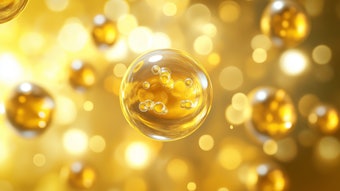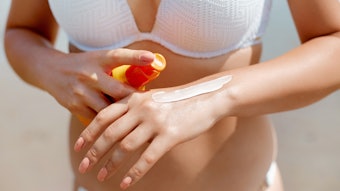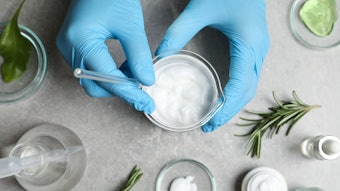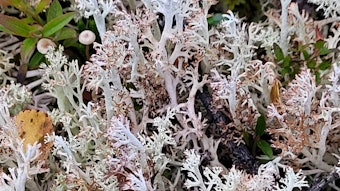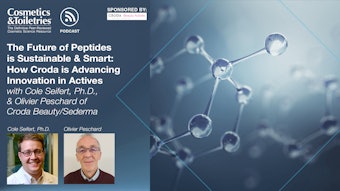Hyperpigmentation in skin typically is caused by the aggregation of melanin in the epidermal basal layer. There are two forms of melanin: eumelanin and pheomelanin, both of which are synthesized in melanocytes. In melanocytes, tyrosine is converted to melanin by the enzyme tyrosinase, whose bioactivity determines this conversion rate. Inhibiting melanin biosynthesis can therefore treat or reduce hyperpigmentation.
So far, inhibiting tyrosinase bioactivity through competitive and copper-interacting mechanisms has been the most effective, and several kinds of synthesized or extracted inhibitors, such as kojic acid and hydroquinone, have been applied in cosmetic whitening products.1 However, their long-term safety is an issue due to side effects such as excessive depigmentation and carcinogenesis.As an alternative, ascorbic acid (AsA), also known as vitamin C, has been used. This well-known natural antioxidant is necessary for the human body to maintain normal physiological functioning. When taken in the recommended dose, it is considered to be nontoxic to humans. As a whitening agent, AsA is more effective than ingredients such as kojic acid and arbutin. Not only can it inhibit tyrosinase bioactivity by interacting with copper ions in tyrosinase to reduce dopaquinone, it also can reverse hyperpigmentation by reducing accumulated melanin directly. In addition, AsA functions to prevent free radical formation;2 it forms intercellular substance;3 it metabolizes amino acids;4 and it synthesizes collagen.5, 6
However, AsA has limited stability in oxidative conditions7 or under light exposure, which limits its applications in cosmetic products. To solve this problem, chemically modified versions have been developed by either esterification of the hydroxyl group with long-chain organic/inorganic acids, or glycosylation with saccharides. These derivatives, including magnesium ascorbyl phosphate,8 ascorbyl palmitate9 and ascorbyl glucoside,10 have proven skin-whitening effects. In the present study, a novel AsA derivative, ascorbyl lactoside (AsL), was prepared based on the reaction between 5, 6-o-isopropylidene-ascorbic acid and acetobromo-alpha-d-lactoside. It consists of a L-ascorbic acid molecule and a lactose molecule bonded by a glycosidic group, as shown in Figure 1.
This small, water-soluble molecule can penetrate through skin’s intercellular spaces and be hydrolyzed into ascorbic acid by lactase. Thus, the safety, tyrosinase inhibition and melanin reduction capabilities of synthesized AsL were evaluated by in vitro experiments for its potential application in cosmetic products.
Materials and Methods
Materials: AsA, AsG, kojic acid, arbutina and AsLb were obtained for the present study. To produce AsL, acetobromo-alpha-d-lactoside was first synthesized from lactose by Friedel-Crafts acylation and bromination, followed by extraction, dehydration and concentration. 5,6-o-Isopropylidene-ascorbic acid was obtained from the reaction of L-ascorbic acid and acetone. AsL was derived from the reaction of acetobromo-alpha-d-lactoside and 5,6-o-isopropylidene-ascorbic acid, followed by deprotection of hydroxyl, purification, concentration and dehydration. Finally, AsA and AsL aqueous solutions were prepared by dissolving AsA and AsL in water (pH 7.0) at a concentration of 0.5 mg/mL. The solutions were stored in the dark at 40°C and analyzed by liquid chromatography to determine their stability. Samples were evaluated in the presence of ascorbate oxidase, which catalyzes the oxidation of AsA by oxygen.
MTT assay, cultured melanocyte cells: To determine the safety of the test ingredients, mouse melanoma cells (B16F10) were placed in 96-well plates at a density of 1×104 cells per well, and cultured at 37°C in 5% CO2 for 24 hr. Following this, 200 μL of culture medium containing different concentrations of whitening ingredients—10.0 mM and 20.0 mM of each concentration—were added to the wells. The samples were incubated for 72 hr.
Then, 20 μL of 5 g/L MTT (3-(4, 5-dimethylthiazole- 2-yl)-2, 5-diphenyl tetrazolium bromide) solution was added to each well and the tissue was incubated for 4 hr at 37°C. After incubation, 150 μL of dimethyl sulfoxide (DMSO) was added to each well, and the plate was shaken for 10 min. The absorbance was measured at 490 nm. All measurements were performed in triplicate. The reproduction rate of each sample was expressed as RA using Equation 1:
RA (%) = Asample/Ablank x 100%
Eq. 1
where Asample and Ablank are the optical density values of the sample and blank, respectively.
In vitro anti-tyrosinase activity: B16F10 (melanoma) cells were placed in 96-well plates at a density of 5×103 cells per well, and cultured at 37°C in 5% CO2 for 24 hr. Then, 200 μL of culture medium containing different concentrations for each whitening ingredient—1.0 mM, 2.5 mM and 5.0 mM of each concentration—were added to each well. After six days of incubation, 100 μL of 0.5% octylphenol ethoxylate surfactantc solution was added to each well, and the plate was shaken for 30 min. Following this, 50 μL of 10 mM L-DOPA solution was added to each well, and the tissue was incubated for 3 hr at 37°C. Absorbance was measured at 490 nm, and the tyrosinase activity of each sample was expressed as TA, using Equation 2:
TA (%) = Asample /Ablank x 100%
Eq. 2
where Asample and Ablank are the optical density values of the sample and blank, respectively.
Melanin reduction: B16F10 (melanoma) cells were placed in 96-well plates at a density of 2×104 cells per well, and cultured at 37°C in 5% CO2 for 24 hr. Then, 6 mL of culture medium containing different concentrations of whitening ingredients were added to each well. After incubation for six days, cells were washed twice with PBS, fixed with 4% paraformaldehyde for 15 min, and incubated in 0.5% L-DOPA for 30 min. Finally, images were obtained using a microscope (100 ×).
Results: Stability
As noted, the stabilities of AsA and AsL aqueous solutions were evaluated in the presence of ascorbate oxidase. As shown in Figure 2, the content of AsA decreased dramatically, to less than 3% within the first 24 hr, and finally reached 0.65% after 48 hr, thus confirming its great instability. In contrast, AsL exhibited good stability against oxidation; more than 85% of its original content remained after 48 hr. These results demonstrated that the introduction of the lactosyl group effectively protected the hydroxyl system of the molecule from oxidation.
Results: Safety
The safety evaluations of AsG, AsL, kojic acid and arbutin showed dose-dependent decreases in metabolic activity of the melanocytes treated with these lighteners in different concentrations (see Figure 3). AsG was highly toxic to melanocytes, decreasing cellular viability to 8% at a concentration of 20 mM, and kojic acid was slightly less toxic than AsG at a higher concentration. In contrast, AsL exhibited much lower cytotoxicity, and only a small decrease (10%) in cellular viability was observed when the concentration increased from 10 mM to 20 mM. In the case of arbutin, its cytotoxicity was similar to AsL at a lower concentration but an obvious decrease in cellular viability was observed at a higher concentration. Based on these results above, it could be concluded that AsL is less cytotoxic to melanocytes than AsG, kojic acid and arbutin at the tested concentrations.
Results: Anti-tyrosinase Activity
As shown in Figure 4, AsG, AsL, kojic acid and arbutin exhibited an inhibitory effect on tyrosinase. Kojic acid had greatest activity, at concentrations of 1.0–5.0 mM. AsL also showed strong activity, suppressing tyrosinase by 80% at a concentration of 5.0 mM. Its effects were dose-dependent, and AsL’s 50% inhibition concentration (IC50) value was 1.0 mM. Arbutin showed similar activity to AsL, and in the same concentration range. In contrast, AsG possessed little activity at concentrations below 2.5 mM, and slight activity at 5 mM.
Results: Melanin Reduction
In addition to inhibiting tyrosinase activity, AsL reduced accumulated melanin in vitro.11 Figure 5 shows, microscopically, the lightening of mouse melanoma cells in the presence of different amounts of AsL, which was dose-dependent. Cells clearly were lightened with the addition of 1.0 mM AsL. Also, compared with AsG, AsL had a better melanin-reduction effect at the same concentration, as shown in Figure 6.
Discussion
The experimental data shown here validates that AsL possesses good stability in aqueous solution, compared with AsA. The in vitro data shown in Figure 4 also proved its low cytotoxicity, anti-tyrosinase and melanin-reduction effects, in comparison with AsG, kojic acid and arbutin—which are well-known actives already used for skin whitening in the cosmetic field.
It is known that the melanin reducibility of AsA is derived from its hydroxy groups, and that AsA derivatives have no inherent capabilities as antioxidants because the hydroxy groups are partially or fully protected by other groups; i.e., lactosylated with lactic acid, in the case of AsL. The function of AsA derivatives is to increase the stability of AsA and protect it from oxidation before it reaches melanocytes. Thus, the activity of AsA derivatives in anti-tyrosinase and melanin reduction is believed to be determined by their molecular chemical activity and the stability of their molecular structure.
AsL and AsG are both AsA derivatives with similar structures, as shown in Figure 7. In AsL, it is the 3’-hydroxyl group that reacts with saccharide; however, it is the 2’-hydroxyl group in AsG. Due to the intramolecular hydrogen bond between the 1’-carbonyl group and 2’-hydroxyl group, the 2’-hydroxyl group is more stable than a 3’-hydroxyl group. Thus, from a structural point of view, the AsL molecule is more stable than AsG. Here, experimental data confirmed that AsL possessed better anti-tyrosinase and melanin reduction activity than AsG.
In addition to whitening effects, the safety of whitening agents has drawn great attention. Several powerful whitening agents, such as kojic acid, have been reported to induce skin-sensitization. However, these tests showed AsL exhibited safer activity than arbutin, which is considered a non-toxic over-the-counter whitening ingredient.
Conclusions
In conclusion, the authors evaluated the stability, safety and anti-melanogenic effects of an AsA derivative: AsL. It exhibited outstanding whitening, safety and stability properties in comparison with AsG, kojic acid and arbutin. Thus, the experimental data indicates AsL is a promising candidate for safe and effective skin whitening.
References
- GR Kanthraj, Skin-lightening agents: New chemical and plant extracts—Ongoing search for the Holy Grail, Indian J Dermatol Venerol Leprol 76 3–6 (2010)
- NJ Lowe and NA Shaath, eds, Sunscreens: Development, Evaluation and Regulatory Aspects, ch 10, Marcel Dekker, New York (1990) pp 279–298
- V Menkin, SB Wolbach and MF Menkin, Formation of intercellular substance by the administration of ascorbic acid (Vitamin C) in experimental scorbutus, Am J Pathol 10 569–576 (1934)
- JJ Burns, JM Rivers and LJ Machlin, Third Conference on Vitamin C, Ann NY Acad Sci 498 1–538 (1987)
- JM Manning and A Meister, Conversion of praline to collagen hydroxyproline, Biochem 5 1154–1165 (1966)
- CL Phillips, SB Combs and SR Pinnell, Effects of ascorbic acid on proliferation and collagen synthesis in relation to the donor age of human dermal fibroblasts, J Invest Dermatol 103 228–232 (1994)
- B ldson, Vitamins and the skin, Cosm & Toil 108 79–94 (1993)
- K Kameyama et al, Inhibitory effect of magnesium L-ascorbyl-2-phosphate (VC-PMG) on melanogenesis in vitro and in vivo, J Am Acad Dermatol 34 29–33 (1996)
- RC Smart and CL Crawford, Effect of ascorbic acid and its synthetic lipophilic derivative ascorbyl palmitate on phorbol ester-induced skin-tumor promotion in mice, Am J Clin Nutr 54 1266–1273 (1991)
- E Miyai, M Yanagida, J Akiyama and I Yamamoto, Ascorbic acid 2-O-alpha-glucoside, a stable form of ascorbic acid, rescues human keratinocyte cell line, SCC, from cytotoxicity of ultraviolet light B, Biol Pharm Bull 19 984–987 (1996)
- J Zhang, Y Fang, X Wu and Y Zhang, Status of skin-whitening cosmetics and their future development, Fine Chemicals 25 72-76 (2008)

